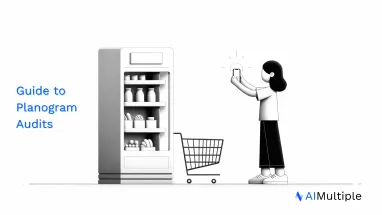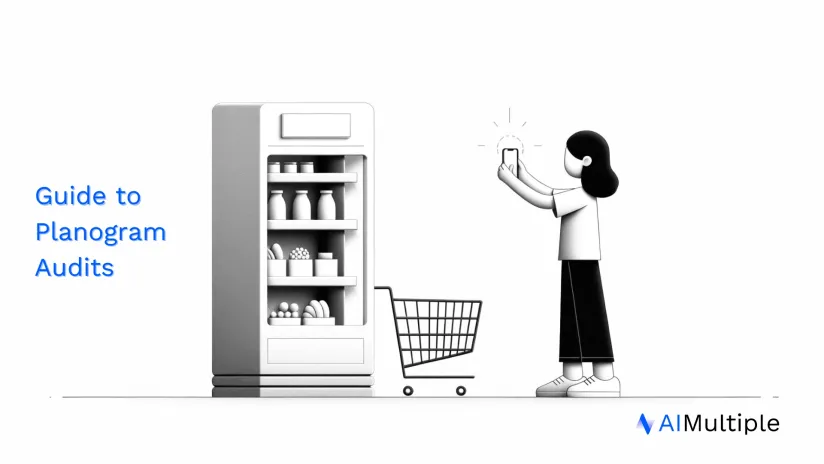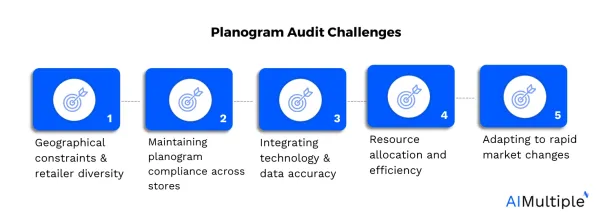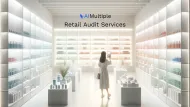Planogram Audit in 2024: Guide & Top 5 Service Providers


While working with various business partners, CPG (consumer packaged goods) or FMCG (fast-moving consumer goods) companies need to implement several strategies to manage the retail environment effectively, including a retail audit. One such strategy is conducting effective planogram audits. However, carrying out regular and efficient planogram audits can be challenging when retailers are spread across the globe. To maintain their brand image and promote sales, companies must ensure these audits are done correctly.
This guide provides an in-depth look at successful planogram auditing, including a comparison of leading services, to help CPG brands navigate challenges and boost retail performance.
Top 5 companies that offer planogram audit as a service
This section offers a table comparing the companies that offer planogram audits as a service.
Table 1. Planogram audit services comparison
| Company/ Service | # of reviews* | Avg User Rating* | Crowd size (in millions)** | Global reach (# of Countries)** |
|---|---|---|---|---|
| Clickworker | 68 | 4.2 | 6+ | 136+ |
| Premise | 23 | 4.6 | 6+ | 140+ |
| BeMyEye | 2 | 3.8 | 3+ | 20+ |
| Field Agent | 13 | 4.5 | 3+ | 8 |
| Roamler | N/A | 4.5 | 0.3+ | 10+ |
* Data gathered from B2B review platforms including G2, TrustRadius and Capterra.
** Based on the companies’ websites
Notes:
- Companies are ranked based on total reviews
- Companies with more than a 200,000 crowd size were included in this comparison.
- All companies offer mystery shopping along with planogram audits.
- They all offer custom dashboards and mystery shopping
- All companies use a crowdsourcing model.
Criteria we used to narrow down the service providers
You can consider the following factors in an effective audit service provider that uses a crowdsourcing model.
- Total # of reviews: This helps understand the market presence of the company and how popular its services are.
- Average user ratings: A higher user rating indicates a better level of satisfaction of customers. However, some companies have a high user rating score but low total reviews; in this case, it is difficult to trust the score.
- Crowd size: Indicates the capability to conduct extensive and diverse audits across various locations, ensuring comprehensive coverage.
- # of countries: Reflects the geographical reach of the service, essential for manufacturers with a global presence in multiple markets.
- Mystery shopping: Provides covert insights also into complete retail compliance, offering a true picture of in-store practices without bias. Mystery shopping can include taking pictures of shelves. These pictures can then be analyzed by brands or their suppliers using computer vision algorithms for audits.
- Custom dashboards: Allows for tailored data analysis and reporting, enabling manufacturers to focus on specific audit metrics and trends.
What is a planogram audit?

Planogram audits refer to the accurate arrangement of products on retail shelves as per a specific layout. This helps to maintain a consistent and appealing display for customers. This layout varies depending on the retailer’s objectives, the product category, and the success criteria. An effective planogram is a visual representation of a store’s product display, designed to maximize sales and enhance the overall shopping experience.
The creation of planograms necessitates the analysis of sales data, comprehension of customer preferences, and strategic decisions regarding product positioning and shelf space distribution. Retailers use planogram software to design and implement planograms properly, providing a clear guideline for store associates on where each product should be placed.
Why are planogram audits important?

1. Maximize sales and shelf space
Planogram audits ensure product displays align with strategic plans, optimizing shelf space and enhancing product visibility. This alignment is crucial for maximizing sales by making products appealing and accessible, preventing lost sales due to suboptimal product placement.
Real-life example
Tesco adopted automated, personalized planograms to optimize retail space, considering each store’s unique characteristics and customer preferences. This strategy significantly improved sales and profitability by enhancing shopping experiences and store performance.1
2. Enhanced product displays
Maintaining planogram compliance ensures consistent and appealing product displays across retail chains, improving customer experience and engagement. This consistency helps customers easily find their preferred products and explore new ones.
3. Improved planogram compliance
Regular audits help maintain compliance with planogram layouts, using technology to verify product placement accuracy. This process ensures that stores adhere to brand standards, reducing discrepancies in product arrangement.
4. Increase efficiency
Implementing planogram strategies through audits streamlines product display processes, making efficient use of resources and enhancing the efficiency of compliance checks. This systematic approach improves the overall execution of product placement strategies.
5. Feedback for improvement
Planogram audits provide critical feedback from the retail environment, offering insights into display performance and consumer demand. This information is invaluable for continuous improvement, helping brands adapt their merchandising strategies and make informed decisions regarding product assortment and stock levels.
What are the challenges in conducting a planogram audit for CPG companies?

1. Geographical constraints and retailer diversity
As you mentioned, one significant challenge is the geographical spread and diversity of retailers, including those in different countries. This makes it difficult for CPG companies to send sales reps or category managers to conduct audits personally. The entire process of auditing becomes complex when dealing with various retail chains, each with its own set of rules and layouts. The logistical and resource demands for ensuring compliance across such a wide array of locations can be substantial, often requiring the adoption of technology and software solutions to manage efficiently.
2. Maintaining planogram compliance across stores
Ensuring planogram compliance is crucial for CPG or FMCG companies to maximize shelf space utilization and enhance consumer engagement. However, due to the dynamic nature of retail environments, maintaining consistent product placement and arrangement as per the planogram strategy can be challenging. Regular audits are necessary to assess compliance, but variations in store size, layout, and local demand can lead to deviations from the intended planogram. This inconsistency can result in missed opportunities and lost sales due to suboptimal product displays.
3. Integrating technology and data accuracy
The adoption of technology, such as digital images, software for visual merchandising, and tools for efficient data collection, is essential for modern planogram audits. However, integrating these technologies into the existing processes of both the CPG companies and the retailers can be challenging. Ensuring the accuracy of the data collected during audits and the efficiency of the technology used is paramount to obtaining actionable insights. Inaccurate data can lead to flawed assessments of planogram compliance and effectiveness, impacting future planogram strategies.
4. Resource allocation and efficiency
Allocating the right resources, including time, personnel, and financial investments, to conduct thorough and regular planogram audits is a significant challenge. CPGs need to balance the costs of auditing with the benefits gained from improved planogram compliance. Efficiently implementing and executing audits without overextending resources or disrupting store operations requires careful planning and execution. Additionally, training employees to conduct audits and use new technologies effectively adds another layer of complexity to resource management.
5. Adapting to rapid market changes
The retail landscape is continuously evolving, with new products, competitors, and consumer demands emerging regularly. CPGs must remain agile and adapt their planogram strategies to reflect these changes. This includes regularly updating planograms to include new product lines, accommodate changing consumer preferences, and respond to competitors’ strategies. The pace at which these adjustments need to be implemented and audited can strain the auditing process, requiring CPGs to be proactive and responsive in their approach to planogram audits.
Benefits of working with a crowdsourcing service provider for planogram audits

1. Global reach and local insights
Crowdsourcing platforms or service providers can leverage their extensive network of local workers across different regions and countries, allowing companies to monitor planogram audit in international markets without the need for physical presence. This is particularly beneficial for multinational corporations that require consistent retail execution across diverse geographical locations.
2. Real-time data collection and reporting
By deploying crowdsourced workers to retail stores, CPGs can receive real-time updates and photos of shelf arrangements, ensuring that products are displayed according to the planogram. This timely data helps in making immediate corrections and informed decisions, enhancing the overall retail strategy.
3. Cost-effective auditing solutions
Utilizing a crowdsourcing service for planogram audit checks eliminates the need for companies to send their own staff to various locations, thereby significantly reducing travel and labor costs. Crowdsourcing provides a flexible and scalable solution that can be adjusted based on the company’s needs and budget.
4. Enhanced accuracy and objectivity
Crowdsourced workers can provide an unbiased view of the retail setup, offering objective insights into planogram audits. Their independent status helps ensure that the data collected is accurate and reflective of the actual retail environment, free from internal biases or oversight.
5. Agile and scalable operations
Crowdsourcing services can quickly adapt to the changing needs of a business, scaling up or down based on the volume of stores that need to be audited. This agility is crucial for companies looking to launch new products, enter new markets, or conduct seasonal compliance checks efficiently, without the constraints of fixed resources or personnel.
FAQs for planogram audits
-
Planogram audit vs planogram analysis
A planogram audit involves verifying store shelves match the planned layout, ensuring compliance. Planogram analysis, on the other hand, assesses the layout’s performance, identifying areas for optimization and enhancement based on sales data and shopper behavior.
-
What does a planogram do?
A planogram is a detailed diagram that illustrates the arrangement of shelves and products in your store. This layout specifies the placement of each item on the shelf, the quantity of products to be exhibited, and any signs or additional visual components the store is to feature.
Further reading
If you need further help in finding a vendor or have any questions, feel free to contact us:
External resources
- 1. Teso Case Study: Automated Store Specifc Planograms. Readkong. Accessed: 23/Feb/2024



Comments
Your email address will not be published. All fields are required.